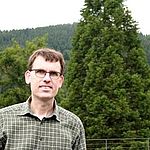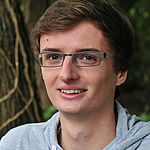The main object of this project are manifolds equipped with a certain class of complete Riemannian metrics, which we call fibred cusp metrics, and generalizations and variants of them.
A fibred cusp metric on a compact manifold with boundary \(M\), and associated to a fibration \(\phi\colon\partial M\to B\) is a Riemannian metric on the interior of \(M\)which near \(\partial M\) takes the form
\(g=\frac{dx^2}{x^2}+\phi^*g_B+x^{2\alpha}g_F\)
in terms of a trivialization \(\left[0,\epsilon\right)\times\partial M\) of a neighborhood of \(\partial M\), where \(x\) is the coordinate on \(\left[0,\epsilon\right)\), \(g_B\) is a Riemannian metric on \(B\) and \(g_F\) is a 'fibre metric' for \(\phi\) (i.e. a symmetric 2-tensor on \(\partial M\) which restricts to a metric on each fibre of \(\phi\)). Generalizations involve a tower of fibrations \(\partial M\to B_{m-1}\to\ldots\to B_0\) with different orders of degeneration for each level of fibre, or a manifold with corners \(M\), where each boundary hypersurface carries fibrations. Variants include conformally equivalent metrics such as \(x^{-2\alpha}g\) (so-called fibred boundary metric).
Such metrics occur on locally symmetric spaces and various moduli spaces, for example. The boundary \(\partial M\), i.e. \(x = 0\), corresponds to 'infinity'.
The goals of this project are to develop analytic tools for analyzing the natural geometric differential operators associated to such metrics and to apply these tools to problems in global analysis and spectral theory. In particular, pseudodifferential calculi and heat calculi adapted to such metrics will be constructed.
Publications
A Calderón projector for an elliptic operator $P$ on a manifold with boundary $X$ is a projection from general boundary data to the set of boundary data of solutions $u$ of $Pu=0$. Seeley proved in 1966 that for compact $X$ and for $P$ uniformly elliptic up to the boundary there is a Calder\'on projector which is a pseudodifferential operator on $\partial X$. We generalize this result to the setting of fibred cusp operators, a class of elliptic operators on certain non-compact manifolds having a special fibred structure at infinity.
This applies, for example, to the Laplacian on certain locally symmetric spaces or on particular singular spaces, such as a domain with cusp singularity or the complement of two touching smooth strictly convex domains in Euclidean space. Our main technical tool is the $\phi$-pseudodifferential calculus introduced by Mazzeo and Melrose.
In our presentation we provide a setting that may be useful for doing analogous constructions for other types of singularities.
Related project(s):
13Analysis on spaces with fibred cusps49Analysis on spaces with fibred cusps II
We study the low energy resolvent of the Hodge Laplacian on a manifold equipped with a fibred boundary metric. We determine the precise asymptotic behavior of the resolvent as a fibred boundary (aka $\phi$-) pseudodifferential operator when the resolvent parameter tends to zero.
This generalizes previous work by Guillarmou and Sher who considered asymptotically conic metrics, which correspond to the special case when the fibres are points. The new feature in the case of non-trivial fibres is that the resolvent has different asymptotic behavior on the subspace of forms that are fibrewise harmonic and on its orthogonal complement. To deal with this, we introduce an appropriate 'split' pseudodifferential calculus, building on and extending work by Grieser and Hunsicker. Our work sets the basis for the discussion of spectral invariants on $\phi$-manifolds.
Related project(s):
13Analysis on spaces with fibred cusps23Spectral geometry, index theory and geometric flows on singular spaces49Analysis on spaces with fibred cusps II
Team Members
Prof. Dr. Daniel Grieser
Project leader
Carl-von-Ossietzky-Universität Oldenburg
daniel.grieser(at)uni-oldenburg.de
Former Members
Malte Behr
Researcher
Carl-von-Ossietzky-Universität Oldenburg



